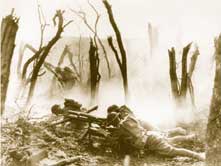United States Enters World War I
On January 31, 1917, however, the German government resumed unrestricted submarine warfare. After five U.S. vessels were sunk, Wilson on April 2, 1917, asked for a declaration of war. Congress quickly approved. The government rapidly mobilized military resources, industry, labor, and agriculture. By October 1918, on the eve of Allied victory, a U.S. army of over 1,750,000 had been deployed in France.

American infantry forces in 1918, firing a 37 mm. gun, advance against German positions in World War I.
(The National Archives)
In the summer of 1918, fresh American troops under the command of General John J. Pershing played a decisive role in stopping a last-ditch German offensive. That fall, Americans were key participants in the Meuse-Argonne offensive, which cracked Germany's vaunted Hindenburg Line.
President Wilson contributed greatly to an early end to the war by defining American war aims that characterized the struggle as being waged not against the German people but against their autocratic government. His Fourteen Points, submitted to the Senate in January 1918, called for: abandonment of secret international agreements; freedom of the seas; free trade between nations; reductions in national armaments; an adjustment of colonial claims in the interests of the inhabitants affected; self-rule for subjugated European nationalities; and, most importantly, the establishment of an association of nations to afford "mutual guarantees of political independence and territorial integrity to great and small states alike."
In October 1918, the German government, facing certain defeat, appealed to Wilson to negotiate on the basis of the Fourteen Points. After a month of secret negotiations that gave Germany no firm guarantees, an armistice (technically a truce, but actually a surrender) was concluded on November 11.
